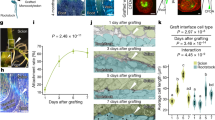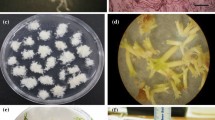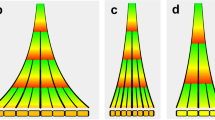Abstract
IT is well known that characteristic changes in leaf-form and growth habit can be induced by treating shoot apices with synthetic growth substances. The question arises as to whether entire plant embryos also can be induced to develop abnormally by the action of growth regulators. For this purpose the solutions must be applied in a suitable manner to the earliest embryo stages through the growing carpel walls, or it would be necessary to remove the still quite small embryos and to expose them in vitro to the proper influences. Both methods are difficult to apply and have as yet proved unsatisfactory.
This is a preview of subscription content, access via your institution
Access options
Subscribe to this journal
Receive 51 print issues and online access
$199.00 per year
only $3.90 per issue
Buy this article
- Purchase on Springer Link
- Instant access to full article PDF
Prices may be subject to local taxes which are calculated during checkout
Similar content being viewed by others
References
Haccius, B., Planta, 41, 439 (1953).
Haccius, B., Experientia, 11, 149 (1955).
Wardlaw, C. W., Growth (Supp.), 13, 93 (1949).
Wardlaw, C. W., and Cutter, E. G., Nature, 174, 734 (1954).
Wardlaw, C. W., Nature, 175, 115 (1955).
Cutter, E. G., Nature, 173, 440 (1954).
Ball, E., Amer. J. Bot., 37, 117 (1950).
Author information
Authors and Affiliations
Rights and permissions
About this article
Cite this article
HACCIUS, B. Experimentally Induced Twinning in Plants. Nature 176, 355–356 (1955). https://doi.org/10.1038/176355a0
Issue Date:
DOI: https://doi.org/10.1038/176355a0
This article is cited by
-
Genetic and epigenetic uniformity of polyembryony derived multiple seedlings of Hevea brasiliensis
Protoplasma (2015)
-
Cleavage polyembryonyin vivo andin vitro
Biologia plantarum (1994)
-
Plant regeneration from cultured immature embryos and inflorescences ofTriticum aestivum L. (wheat): Evidence for somatic embryogenesis
Protoplasma (1982)
-
Germination characters in wild and cultivated Anemone coronaria L.
Euphytica (1975)
-
Anomalien der Pflanzlichen Embryo-Entwicklung nach Anwendung von 2,4-D-haltigen Herbiziden
Qualitas Plantarum et Materiae Vegetabiles (1965)
Comments
By submitting a comment you agree to abide by our Terms and Community Guidelines. If you find something abusive or that does not comply with our terms or guidelines please flag it as inappropriate.



